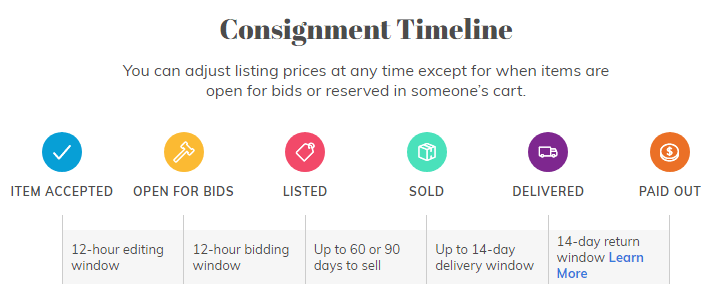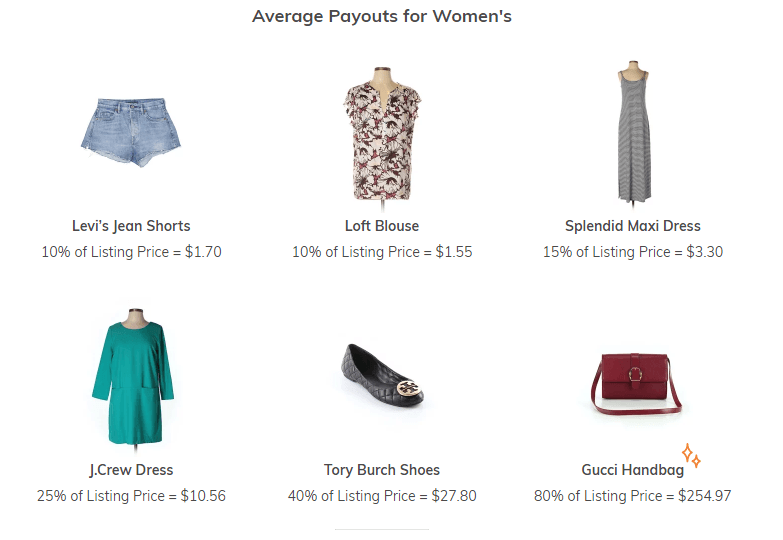
Every one of us has a piece or two garments (maybe more) in our closet that has reselling values. If you are thinking about recycling your clothes this way, you may have heard of an online consignment store called ThredUp. It’s a thriving marketplace that gives second-hand clothes a new life, but here’s the question – can you make money on Thredup?
This review aims to answer that question by looking back at some past seller’s experiences and finding out if the new system will serve you any benefits or not.
ThredUp at a Glance
Established in 2009, Thredup was created as a fashion platform for people to buy and sell gently used women and children’s clothing online. Other items they will accept include shoes, bags, maternity as well as jewelry.
For the customers, it’s a great way to purchase fairly good quality clothing at inexpensive prices and for the sellers, it’s a convenient avenue to get rid of unwanted clothes and monetize from the remaining values of these items.
At the point of this writing, the company has just rolled out a new payment scheme (in August 2019) so the payout you see in past reviews may not be relevant anymore moving forward. Also, due to the massive complaints of unfair prices, I think the new structure will provide more transparency and prevent misunderstandings among sellers in the future.
ThredUp (New) Selling System
In the past, you can either receive payment upfront (lower value, faster pay) or consignment (higher value, slower pay) through the old system. With the new system, earnings are purely from consignment so a much longer wait is to be expected.

However, the advantages are also very obvious here.
- The earning percentage is higher.
- You can adjust the item’s pricing based on what you think it’s valued for.
- Your items get sold faster through a bidding process.
- You have up to 90 days to sell.
- You can reclaim the item if it doesn’t sell at all.
In a way, it gives the seller more control, an element that was severely lacking in the past. Hence, all the negative reviews you read before this. The new system does seem more favorable but before ordering the Clean Out Bag – the kit in which you deliver all the gently used clothes – there are a few criteria you need to be aware of.
- Firstly, decide whether you want to donate the items (women’s, men’s, kid’s) OR sell for cash/credit. When donating, Thredup will give you a tax receipt and pay $5 per bag on your behalf to support various charity missions.
- For selling, you can choose between the free standard processing (takes about 3 weeks) or the expedited one (takes about 1 week but there’s a $16 processing fee).
- ThredUp claims that they only accept an average 40% of items in a kit which means you need to decide what to do with the remaining 60%. If you choose to recycle, the items will be relinquished to the company but if you want to reclaim, they will mail back all the items for a $10.99 return fee.
- Apart from quality and style, clothing is mainly categorized according to brand names (about 35,000 of them) and that is what determines the listing period on the marketplace. Value and Mall brands such as Target and Gap list for 60 days while premium and designer brands such as Lululemon and Prada will list for 90 days. If none of the items sell within these periods, you have an additional 14 days to reclaim or else, relinquish.
- According to the payout structure (see table below), you can make anywhere between 5% to 80% off a sale, but this is largely dependant on the listing price.

Alternatively, you can also calculate the value and earning percentage by using the Payout Estimator on this page.
If so happens they are running a seasonal promotion, you could get an additional payout bonus for certain brands.
Once you are more or less aware of what’s going to happen to all your unwanted but beautiful clothes, you may order a prepaid bag (can take up to 2 weeks to arrive) or get them to email a prepaid shipping label to be used on any delivery boxes.
And that’s basically how you ship, list and make money selling on ThredUp.
The Pros
Ok, so what are the perks one can get from this trade-off? Here’s what we like about the new system.
- Doing it online is a convenient way to clear out your closet without having to haul items to physical stores.
- Having the ability to watch the sales from start to finish helps you to keep track of an item’s progress in the crowded marketplace.
- Adjusting the price to your liking is also a good thing – even though you are only given a short time to do this. Better than nothing.
- If you don’t want the unaccepted items returned to you, opting for responsible recycling isn’t a bad thing. At least you are doing something good for the environment.
- If you don’t want cash, you can also convert earnings into credits and shop (for free) on ThredUp.
- Addicted to shopping on ThredUp? You can earn more credits by referring new users to the platform through your referral link. When someone places their first order, they get a $10 bonus and you get $10 credit to shop some more. This link can be shared when recommending the platform through blogs or social media and it works pretty much like affiliate marketing, except that it’s not actually pure cash.
The Cons
Yet the perks don’t really diminish the realities you would have to deal with – ThredUp’s strict criteria and consignment processing.
- For one, items are highly categorized into labels and it seems like only stylish, high quality, branded clothing will make it to the online rack. And we know what these items cost at retail when you purchase them – they are not cheap. Simply because they become a second hand, their values just plummet making your earning percentage much lower.
- If you study the payout structure carefully and factor in the 40% acceptance rate, you actually need a lot of items marked with higher listing prices to make a significant amount of money. In fact, the whole purpose of selling is almost like trying to recoup from what you’ve spent in the first place so it isn’t like you are making 100% profit.
- The consignment timeline says it loud and clear – the process from sending to listing on the marketplace is time-consuming with no guarantee of selling. If no one bids on your item during the 12-hour window, be prepared to wait for 2 to 3 months before the item gets a buyer. Only then will you get your money, if it sells at all. Are you willing to wait that long for a couple of dollars? It’s up to you.
So, Is It Worth Selling on ThredUp?
To survive the trading ordeal with ThredUp, it’s best to go in with a low-expectation mindset that you will not be making a substantial amount of money. Whether your time is worth it or not, it really depends on how much effort you invested in the whole thing.
If you find the prices/fees to be unfair, remember there’s always the other option to do otherwise. Hence, there’s very little we could complain about moving forward. The new payout system is all about transparency and providing everyone a more rewarding experience. Whether you agree with it or not is a different issue altogether.
Honestly, I find it tricky to make money with second items unless you are really good at refurbishing or upcycle. Without value-adding, I don’t see how you can generate anything close to being profitable. I would much rather deal with first-hand items that are highly sought after and has higher tangible values.
If you are still interested in making money from fashion and clothing, I strongly recommend starting with affiliate marketing. In this income model, you can leverage from preexisting brands by referring new customers to their online stores.
That’s how most aspiring fashion stylists start an online business through a blog or a YouTube channel. Even if you aren’t into fashion, you can do something totally different. There are thousands of niches online, waiting to be monetized from our everyday trend.
To learn more about affiliate marketing, sign up for a free trial with my recommended training platform and see if it’s for you.
In case you have any questions or comments to add, let me know in the space down below.

This is the first time I am hearing about Thredup. Though it’s an interesting concept, I would just donate my clothes. If it is a real sale item, I would use something like a Cragislist to list and then meet up with the buyer to sell. It sounds kind of creepy the way I wrote it, but it works! I guess because it is such a large site and people are constantly looking to buy second-hand stuff 🙂
This sounds a lot like Thrifty and Goodwill, with some extra perks of making money from used clothes. Do they have clear instructions on how to go about the selling process? I’ve only donated clothes so far so it sounded kind of complicated to me.
I had no experience selling any else except donating all of them to Goodwill or Thirfty.
It’s not that difficult Carolyn. They do provide step by step from packing to shipping the items. As mentioned, the new system is more transparent than the old ones so you should be very clear about what you are getting from the trading process.
If they are bothered about quality, I have a lot of top quality clothes and shoes here that I would love to sell out to people because I have lost interest in them. I even have some clothes which I have yet to put on simply because they are just not my size anymore.
The possibility of making money with ThredUp sounds more exciting than selling on eBay. I am not expecting a lot here but there’s no harm trying, right.
Only $5 per bag with donating items. Not bad. I can take to my local drop off here and get around $25 to $50 tax credit. So that’s about the same. If you want to clean out your closet and save time then this might be ok. I use eBay and Facebook Marketplace for my high ticket items and use Goodwill or Salvation Army for my dump items.
I get around $500 tax break which only helps if my tax credit is more than my standard deduction. My local church took around 3 bags of gently used clothes and I know they went to a good cause for local kids needing clothes. Thredup looks legit for really nice designer clothes – otherwise, everything else looks like a waste of time.
Seems like a good platform for earning extra money from what you already have. Using the donation method can also help communities who are in need rather than just throwing those stuff away. If many people engage in using ThredUp more frequently to recycle their clothes, it could be the next big thing.
There are lots of people like myself who have boxes filled with clothes we aren’t using and seem to be taking space in the house. Personally, for me, I am used to throwing them away, but sometimes I donate out. Currently, I have a few items that are either too big or too small for me to wear. They are still brand new and I’d love to sell them through consignment and hopefully, get some of my money back. Will look into ThredUp for sure.